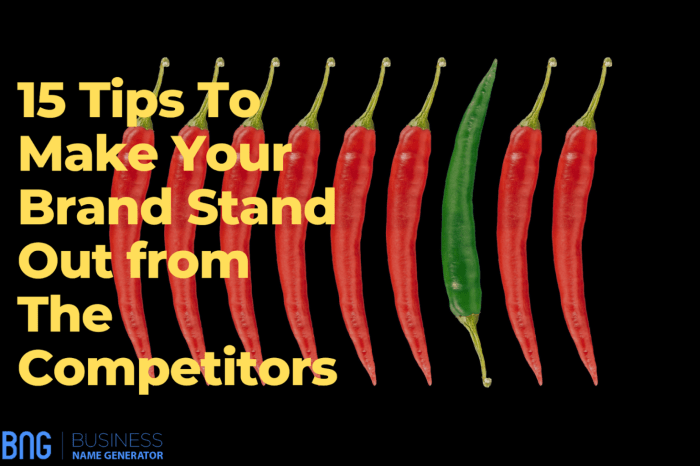
Defining Brand Differentiation

In today’s saturated marketplace, brand differentiation is no longer a luxury but a necessity for survival. It’s the strategic process of creating a unique and compelling brand identity that sets a company apart from its competitors, capturing the attention and loyalty of its target audience. Without a clear differentiator, businesses risk becoming indistinguishable commodities, losing their competitive edge and ultimately, market share.Brand differentiation goes beyond simply having a logo and a name.
It involves a deep understanding of the target market, identifying unmet needs, and crafting a value proposition that resonates deeply with consumers. This involves careful consideration of all aspects of the brand, from its messaging and visual identity to its product features and customer service. The ultimate goal is to create a distinct and memorable brand experience that fosters customer loyalty and advocacy.
Successful Brand Differentiation Strategies
Several brands have successfully carved out unique positions in their respective markets through innovative differentiation strategies. Consider Apple, for example. Their differentiation isn’t solely about technological innovation, although that plays a significant role. It’s also about a meticulously crafted brand experience centered around design aesthetics, user-friendliness, and a premium image. This holistic approach has cemented Apple’s position as a leader in the technology industry.
Similarly, Nike’s differentiation strategy centers on athletic performance and empowerment, fostering a strong emotional connection with its consumers through inspirational marketing campaigns and endorsements by high-profile athletes. This emotional resonance has transformed Nike into a global icon, extending far beyond simply selling athletic footwear and apparel. Finally, Southwest Airlines has differentiated itself through its focus on low-cost, no-frills travel and a playful, customer-centric brand personality, creating a unique niche in the airline industry.
Comparative Analysis: Coca-Cola and Pepsi
Coca-Cola and Pepsi, two titans of the soft drink industry, offer a compelling case study in contrasting brand differentiation strategies. While both companies offer cola beverages, their approaches to differentiation differ significantly. Coca-Cola, with its long history and iconic branding, has cultivated a sense of nostalgia and tradition. Their marketing often evokes feelings of happiness and shared experiences, building a strong emotional connection with consumers.
Pepsi, on the other hand, has frequently positioned itself as the younger, more rebellious alternative, targeting a more contemporary audience through pop culture collaborations and edgy marketing campaigns. This approach focuses on creating a sense of excitement and modernity, differentiating itself from Coca-Cola’s more classic image. The difference is not just in the taste, but in the overall brand experience and the target consumer they aim to attract.
This competitive dynamic highlights how even within a seemingly homogenous market, effective brand differentiation can lead to sustained success for competing brands.
Value Proposition as a Differentiator
A compelling value proposition is the cornerstone of effective brand differentiation. It articulates the unique value a brand offers to its customers, clearly explaining why they should choose that brand over competitors. This goes beyond simply listing features; it focuses on the benefits those features deliver and how they address specific customer needs and desires. A well-crafted value proposition acts as a powerful magnet, attracting the right customers and building brand loyalty.A strong value proposition requires a deep understanding of customer needs and the competitive landscape.
It must be concise, memorable, and easily understood, resonating with the target audience on an emotional and rational level. Crafting such a proposition involves careful consideration of various value types and a meticulous targeting process.
Defining a Compelling Value Proposition: An Example
Let’s consider a fictional brand, “Everbloom,” a subscription box service delivering curated bouquets of rare and exotic flowers. Everbloom’s value proposition is: “Experience the extraordinary. Everbloom delivers breathtaking bouquets of rare and exotic flowers, hand-selected by expert florists, directly to your door, transforming your everyday moments into unforgettable celebrations.” This statement highlights the unique product offering (rare flowers), the exceptional service (hand-selected, direct delivery), and the emotional benefit (transforming everyday moments).
It avoids generic claims and focuses on a specific, desirable outcome for the customer.
Types of Value Propositions
Value propositions can be categorized into several types, each appealing to different customer motivations.
- Functional Value: This focuses on the practical benefits a product or service provides. For example, a car company might highlight its superior fuel efficiency or safety features. Everbloom, in this context, offers the functional value of convenience—receiving beautiful flowers without the hassle of shopping and arranging them.
- Emotional Value: This appeals to customers’ feelings and aspirations. A luxury handbag brand might emphasize the feeling of exclusivity and sophistication it provides. Everbloom’s value proposition strongly taps into emotional value by promising to transform everyday moments into unforgettable celebrations, evoking feelings of joy, beauty, and appreciation.
- Self-Expressive Value: This relates to how a product or service helps customers express their identity and values. A sustainable clothing brand might emphasize its commitment to ethical production and environmental responsibility. Everbloom could leverage self-expressive value by associating its exotic flowers with sophistication, unique taste, and a desire for the extraordinary. This could be further amplified through marketing materials showcasing customers enjoying the bouquets in aspirational settings.
Identifying the Target Audience and Tailoring the Value Proposition
Before crafting a value proposition, identifying the target audience is crucial. This involves understanding their demographics, psychographics, needs, and aspirations. For Everbloom, the target audience might be affluent professionals aged 30-55, who appreciate beauty, luxury, and convenience, and are willing to pay a premium for unique experiences. Their aspirations might include self-expression, creating memorable moments, and impressing others.Once the target audience is defined, the value proposition must be tailored to resonate with their specific needs and aspirations.
For Everbloom, this means emphasizing the unique and exotic nature of the flowers, the convenience of the subscription service, and the emotional benefits of receiving beautiful flowers regularly. The marketing message should use language and imagery that appeal to their sense of sophistication and appreciation for the finer things in life. For instance, advertising could focus on the artistry of the floral arrangements and the exclusivity of the flowers, rather than solely on price or convenience.
Branding Elements for Differentiation

Effective brand differentiation relies heavily on the strategic use of consistent and memorable branding elements. These elements work together to create a unique brand identity, setting a company apart from its competitors and resonating with its target audience. Careful consideration and consistent application of these elements across all brand touchpoints are crucial for building a strong and recognizable brand.
Several key branding elements contribute significantly to differentiation. These elements, when thoughtfully designed and implemented, create a cohesive and impactful brand experience.
Branding Elements and Their Contribution to Differentiation
The following table details key branding elements and their role in establishing a distinct brand identity. A well-defined strategy across these elements ensures that the brand message is consistently communicated, leading to stronger brand recognition and recall.
| Brand | Logo Description | Color Palette | Brand Voice |
|---|---|---|---|
| Apple | A simple, minimalist apple silhouette, conveying a sense of modernity and sophistication. | Silver, white, and shades of gray, projecting a clean and premium aesthetic. | Friendly, approachable, yet innovative and forward-thinking. |
| Coca-Cola | A classic, instantly recognizable script logo, evoking feelings of nostalgia and tradition. | Red and white, creating a bold and energetic visual identity. | Optimistic, playful, and timeless. |
| Nike | A simple swoosh, representing movement, speed, and dynamism. | Black, white, and a vibrant red, conveying power and athleticism. | Confident, empowering, and focused on achievement. |
| Starbucks | A stylized siren, symbolizing coffee and its global appeal. | Greens and browns, reflecting the natural origins of coffee. | Warm, welcoming, and inviting. |
Consistent Application Across Brand Touchpoints
Maintaining consistency in branding elements across all brand touchpoints—from website design and social media presence to packaging and marketing materials—is paramount. Inconsistent application dilutes brand messaging and weakens brand recognition. For example, if Apple used a different logo on its packaging compared to its website, it would confuse consumers and damage its carefully cultivated image of simplicity and elegance.
Consistent application reinforces the brand’s identity and strengthens its differentiation.






